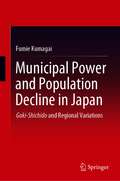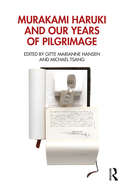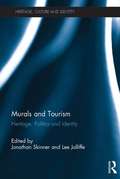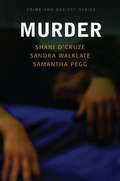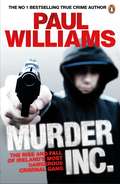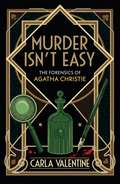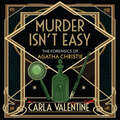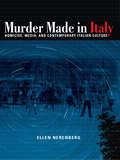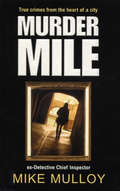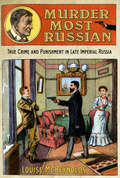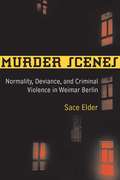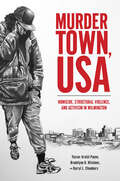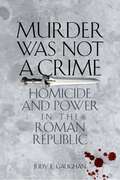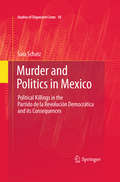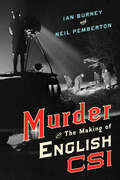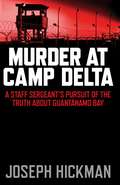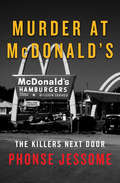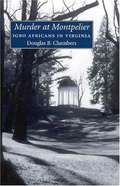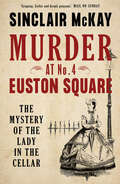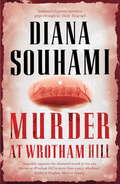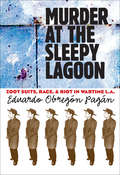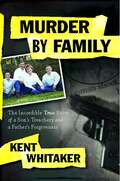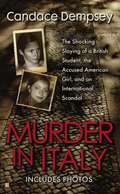- Table View
- List View
Municipal Power and Population Decline in Japan: Goki-Shichido and Regional Variations
by Fumie KumagaiThis book provides an insightful sociological study of the declining Japanese population, using statistical analysis to establish the significance of municipal power using demographic data on national, regional, prefectural and municipal levels. Penned by one of Japan's eminent sociologists, it provides a quantitative characterization of population decline in Japan with a focus on regional variation, and identifies the principal explanatory factors through GPI statistical software tools such as G-census and EvaCva, within a historical perspective. Furthermore, it offers a qualitative assessment of what constitutes ‘municipal power’ as this relates to regional/local revitalization as a means of addressing municipal population decline. Using Goki-Shichido as a theoretical framework, this book pays special attention to municipal variations within the same prefecture, presenting a completely unique approach. In combining these two dimensions of analyses, the book successfully reveals the impact of municipal power and socio-cultural identity of social capital in the region, from both quantitative and qualitative perspectives at the municipal level. Demography issues in Japan have been receiving increasing attention among researchers given the growing number of declining populations in developed countries, in tandem with rapid aging and low fertility trends. Providing an original and unique contribution to regional population analysis in the fields of regional demography, historical demography and regional population policy, this book shows that the revitalization of the community is vital if Japan is to increase its population, so as to renew a community ‘raison d'être’. The book is of interest to scholars of Asian studies more broadly, and to sociologists, demographers, and policymakers interested in population studies, specifically."Providing an informative and vivid overview of the demographic situation of Japan, the author offers excellent suggestions for effective regional policy in confronting a shrinking society. This book presents a unique analysis of the regional variations on small municipal levels, with demographic variables, social indicators and historical identities. An original contribution to regional population analysis in the fields of regional population policy, regional demography and historical demography."- Toshihiko Hara, Professor Emeritus, Sapporo City University
Municipalities and Multiculturalism
by Kristin GoodThe Canadian model of diversity management is considered a success in the international community, yet the methods by which these policies are adopted by local governments have seldom been studied. Municipalities and Multiculturalism explores the role of the municipality in integrating immigrants and managing the ethno-cultural relations of the city.Throughout the study, Kristin R. Good uses original interviews with close to 100 local leaders of eight municipalities in Toronto and Vancouver, two of Canada's most diverse urban and suburban areas. Grounded by Canada's official multiculturalism policies, she develops a typology of responsiveness to immigrants and ethno-cultural minorities and offers an explanation for policy variations among municipalities.Municipalities and Multiculturalism is an important examination of the differing diversity management methods in Canadian cities, and ultimately contributes to debates concerning the roles that municipal governments should play within Canada's political system.
Murakami Haruki and Our Years of Pilgrimage
by Michael Tsang Gitte Marianne HansenThis book is a timely and expansive volume on Murakami Haruki, arguably Japan's most high-profile contemporary writer. With contributions from prominent Murakami scholars, this book approaches the works of Murakami Haruki through interdisciplinary perspectives, discussing their significance and value through the lenses of history; geography; politics; gender and sexuality; translation; and literary influence and circulation. Together the chapters provide a multifaceted assessment on Murakami’s literary oeuvre in the last four decades, vouching for its continuous importance in understanding the world and Japan in contemporary times. The book also features exclusive material that includes the cultural critic Katō Norihiro’s final work on Murakami – his chapter here is one of the few works ever translated into English – to interviews with Murakami and discussions from his translators and editors, shedding light not only on Murakami’s works as literature but as products of cross-cultural exchanges. Murakami Haruki and Our Years of Pilgrimage will prove a valuable resource for students and scholars of Japanese studies, comparative and world literature, cultural studies, and beyond.
Murals and Tourism: Heritage, Politics and Identity (Heritage, Culture and Identity)
by Jonathan SkinnerAround the world, tourists are drawn to visit murals painted on walls. Whether heritage asset, legacy leftover, or contested art space, the mural is more than a simple tourist attraction or accidental aspect of tourism material culture. They express something about the politics, heritage and identity of the locations being visited, whether a medieval fresco in an Italian church, or modern political art found in Belfast or Tehran. This interdisciplinary and highly international book explores tourism around murals that are either evolving or have transitioned as instruments of politics, heritage and identity. It explores the diverse messaging of these murals: their production, interpretation, marketing and – in some cases – destruction. It argues that the mural is more than a simple tourist attraction or accidental aspect of tourism material culture. Murals and Tourism will be valuable reading for those interested in cultural geography, tourism, heritage studies and the visual arts.
Murder (Crime and Society Series)
by Samantha Pegg Shani D'Cruze Sandra L. WalklateThis book seeks to unravel the issues associated with the crime of murder, providing a highly accessible account of the subject for people coming to it for the first time. It uses detailed case studies as a way of exemplifying and exploring more general questions of socio-cultural responses to murder and their explanation. It incorporates a historical perspective which both provides some fascinating examples from the past and enables readers to gain a vision of what has changed and what has remained the same within those socio-cultural responses to murder. The book also embraces questions of race and gender, in particular cultural constructions of masculinity and femininity on the one hand, and the social processes of 'forgetting and remembering' in the context of particular crimes on the other. Particular murders analysed included those of Myra Hindley, Harold Shipman and the Bulger murder.
Murder Inc.: The Rise and Fall of Ireland's Most Dangerous Criminal Gang
by Paul WilliamsMurder Inc. is the latest blockbuster by Ireland's most respected crime writer and journalist, Paul Williams. Murder Inc. is the definitive account of how organized crime exploded in Limerick from the 1990s and in the noughties. It describes the depravity and decadence of the gangs, their deadly rivaliries, and their reigns of terror over the community in which they lived. Finally, Williams traces the faultlines that eventually led to the implosion of the gangs and their defeat.Drawing on his vast inside knowledge of the criminal underworld, an unparalleled range of contacts and eye witness interviews, Paul Williams provides a chilling insight into the mobsters and events that corroded entire neighbourhoods and devastated countless lives.
Murder Isn't Easy: The Forensics of Agatha Christie
by Carla ValentineFascinating - PrimaAgatha Christie is one of our most beloved authors - a storyteller unparalleled in her clever plots and twisting tales. But Agatha was also a forensic expert; in each of her books she employs an expert weaving of human observation, ingenuity and genuine science of the era.In Murder Isn't Easy Carla Valentine illuminates all of Agatha's incredible knowledge, showing how she stayed at the cutting edge of forensics from ballistics to fingerprint analysis, as seen through much-loved characters such as Poirot and Miss Marple.From the glamour and grit of Agatha Christie's stories, to the real-life cases that inspired them, Murder Isn't Easy will immerse you in the forensics that influenced generations of writers and scientists alike.
Murder Isn't Easy: The Forensics of Agatha Christie
by Carla ValentineFascinating - PrimaEngaging and informative - GuardianAgatha Christie is one of our most beloved authors - a storyteller unparalleled in her clever plots and twisting tales. But Agatha was also a forensic expert; in each of her books she employs an expert weaving of human observation, ingenuity and genuine science of the era.In Murder Isn't Easy Carla Valentine illuminates all of Agatha's incredible knowledge, showing how she stayed at the cutting edge of forensics from ballistics to fingerprint analysis, as seen through much-loved characters such as Poirot and Miss Marple.From the glamour and grit of Agatha Christie's stories, to the real-life cases that inspired them, Murder Isn't Easy will immerse you in the forensics that influenced generations of writers and scientists alike.
Murder Made in Italy: Homicide, Media, And Contemporary Italian Culture
by Ellen NerenbergLooking at media coverage of three very prominent murder cases, Murder Made in Italy explores the cultural issues raised by the murders and how they reflect developments in Italian civil society over the past 20 years. Providing detailed descriptions of each murder, investigation, and court case, Ellen Nerenberg addresses the perception of lawlessness in Italy, the country's geography of crime, and the generalized fear for public safety among the Italian population. Nerenberg examines the fictional and nonfictional representations of these crimes through the lenses of moral panic, media spectacle, true crime writing, and the abject body. The worldwide publicity given the recent case of Amanda Knox, the American student tried for murder in a Perugia court, once more drew attention to crime and punishment in Italy and is the subject of the epilogue.
Murder Mile
by Mike MulloyLife was cheap in the Toxteth and Wavertree districts of Liverpool, and more murders were committed there than in any other part of the city; and so this tough inner-city area became known as Murder Mile. Rising to the rank of Detective Chief Inspector, and becoming the most commended officer in the history of the force, Mike Mulloy had the job of investigating a series of high-profile cases over the years involving murder, arson, rape, armed robbery, drug dealing, burglary and bombing. He and his colleagues witnessed the most appalling brutality and violence where neither age nor sex provided any defence - young children, women and old people were constantly vulnerable.MURDER MILE is a fascinating and engaging addition to the literature of True Crime, written by a man who put his life on the line in the defence of the public and who saw it all at first-hand.
Murder Most Russian: True Crime and Punishment in Late Imperial Russia
by Louise McreynoldsHow a society defines crimes and prosecutes criminals illuminates its cultural values, social norms, and political expectations. In Murder Most Russian, Louise McReynolds uses a fascinating series of murders and subsequent trials that took place in the wake of the 1864 legal reforms enacted by Tsar Alexander II to understand the impact of these reforms on Russian society before the Revolution of 1917. For the first time in Russian history, the accused were placed in the hands of juries of common citizens in courtrooms that were open to the press. Drawing on a wide array of sources, McReynolds reconstructs murders that gripped Russian society, from the case of Andrei Gilevich, who advertised for a personal secretary and beheaded the respondent as a way of perpetrating insurance fraud, to the beating death of Marianna Time at the hands of two young aristocrats who hoped to steal her diamond earrings.As McReynolds shows, newspapers covered such trials extensively, transforming the courtroom into the most public site in Russia for deliberation about legality and justice. To understand the cultural and social consequences of murder in late imperial Russia, she analyzes the discussions that arose among the emergent professional criminologists, defense attorneys, and expert forensic witnesses about what made a defendant's behavior "criminal." She also deftly connects real criminal trials to the burgeoning literary genre of crime fiction and fruitfully compares the Russian case to examples of crimes both from Western Europe and the United States in this period.Murder Most Russian will appeal not only to readers interested in Russian culture and true crime but also to historians who study criminology, urbanization, the role of the social sciences in forging the modern state, evolving notions of the self and the psyche, the instability of gender norms, and sensationalism in the modern media.
Murder Scenes: Normality, Deviance, and Criminal Violence in Weimar Berlin
by Sace ElderUsing police reports, witness statements, newspaper accounts, and professional publications, Murder Scenes examines public and private responses to homicidal violence in Berlin during the tumultuous years of the Weimar era. Criminology and police science, both of which became increasingly professionalized over the period, sought to control and contain the blurring of these boundaries but could only do so by relying on a public that was willing to participate in the project. These Weimar developments in police practice in Berlin had important implications for what Elder identifies as an emerging culture of mutual surveillance that was successful both because and in spite of the incompleteness of the system police sought to construct, a culture that in many ways anticipated the culture of denunciation in the Nazi period. In addition to historians of Weimar, modern Germany, and modern Europe, German studies and criminal justice scholars will find this book of interest.
Murder Town, USA: Homicide, Structural Violence, and Activism in Wilmington (Critical Issues in Crime and Society)
by Yasser Arafat Payne Brooklynn K. Hitchens Darryl L. ChambersFar too many poor Black communities struggle with gun violence and homicide. The result has been the unnatural contortion of Black families and the inter-generational perpetuation of social chaos and untimely death. Young people are repeatedly ripped away from life by violence, while many men are locked away in prisons. In neighborhoods like those of Wilmington, Delaware, residents routinely face the pressures of violence, death, and incarceration. Murder Town, USA is thus a timely ethnography with an innovative structure: the authors helped organize fifteen residents formerly involved with the streets and/or the criminal justice system to document the relationship between structural opportunity and experiences with violence in Wilmington's Eastside and Southbridge neighborhoods. Earlier scholars offered rich cultural analysis of violence in low-income Black communities, and yet this literature has mostly conceptualized violence through frameworks of personal responsibility or individual accountability. And even if acknowledging the pressure of structural inequality, most earlier researchers describe violence as the ultimate result of some moral failing, a propensity for crime, and the notion of helplessness. Instead, in Murder Town USA, Payne, Hitchens, and Chamber, along with their collaborative team of street ethnographers, instead offer a radical re-conceptualization of violence in low-income Black communities by describing the penchant for violence and involvement in crime overall to be a logical, "resilient" response to the perverse context of structural inequality.
Murder Was Not a Crime: Homicide and Power in the Roman Republic (Ashley and Peter Larkin Series in Greek and Roman Culture)
by Judy E. GaughanEmbarking on a unique study of Roman criminal law, Judy Gaughan has developed a novel understanding of the nature of social and political power dynamics in republican government. Revealing the significant relationship between political power and attitudes toward homicide in the Roman republic, Murder Was Not a Crime describes a legal system through which families (rather than the government) were given the power to mete out punishment for murder. With implications that could modify the most fundamental beliefs about the Roman republic, Gaughan's research maintains that Roman criminal law did not contain a specific enactment against murder, although it had done so prior to the overthrow of the monarchy. While kings felt an imperative to hold monopoly over the power to kill, Gaughan argues, the republic phase ushered in a form of decentralized government that did not see itself as vulnerable to challenge by an act of murder. And the power possessed by individual families ensured that the government would not attain the responsibility for punishing homicidal violence. Drawing on surviving Roman laws and literary sources, Murder Was Not a Crime also explores the dictator Sulla's "murder law," arguing that it lacked any government concept of murder and was instead simply a collection of earlier statutes repressing poisoning, arson, and the carrying of weapons. Reinterpreting a spectrum of scenarios, Gaughan makes new distinctions between the paternal head of household and his power over life and death, versus the power of consuls and praetors to command and kill.
Murder and Politics in Mexico
by Sara SchatzMurder and Politics in Mexico studies the causes of political killings in Mexico's liberalization-democratization within the larger context of political repression. Mexico's democratization process has entailed a little known but highly significant cost of human lives in pre- and post-election violence. The majority of these crimes remain in a state of impunity: in other words, no person had been charged with the crime and/or no investigation of it had occurred. This has several consequences for Mexican politics: when the level of violence is extreme and when political killings that are systematic and invasive are involved, this could indicate a real fracture in the democratic system. This book analyzes several dimensions regarding impunity and political crime, more specifically, the political killings of members of the PRD in the post-1988 period in Mexico. The main argument proposed in this book is that impunity for political killings is a structured system requiring one central precondition, namely the failure of the legal system to function as a system of restraint for killings. Dr Schatz's research finds that political assassinations are indeed rational, targeted actions but they do not occur within an institutional vacuum. Political assassinations are calculated strategies of action aimed at eliminating political rivals. As a form of interpersonal violence, political assassination involves direct or implied authorization from political leaders, the availability of assassins for hire and the willingness of some political leaders to utilize them against political opponents, and violent interactions between political parties combined with judicial system ineffectiveness. A corrupt legal system facilitates the use of political assassination and explains the persistence of impunity for political murder over time. To reduce political violence in the transition to electoral democracy, specific institutional conditions, namely a structured system of impunity for murder, must be overcome.
Murder and the Making of English CSI
by Ian Burney Neil PembertonA history of the origins and development of forensic science in murder investigations in early twentieth-century England.Crime scene investigation—or CSI—has captured the modern imagination. On television screens and in newspapers, we follow the exploits of forensic officers wearing protective suits and working behind police tape to identify and secure physical evidence for laboratory analysis. But where did this ensemble of investigative specialists and scientific techniques come from?In Murder and the Making of English CSI, Ian Burney and Neil Pemberton tell the engrossing history of how, in the first half of the twentieth century, novel routines, regulations, and techniques—from chain-of-custody procedures to the analysis of hair, blood, and fiber—fundamentally transformed the processing of murder scenes. Focusing on two iconic English investigations—the 1924 case of Emily Kaye, who was beaten and dismembered by her lover at a lonely beachfront holiday cottage, and the 1953 investigation into John Christie’s serial murders in his dingy terraced home in London’s West End—Burney and Pemberton chart the emergence of the crime scene as a new space of forensic activity.Drawing on fascinating source material ranging from how-to investigator handbooks and detective novels to crime journalism, police case reports, and courtroom transcripts, the book shows readers how, over time, the focus of murder inquiries shifted from a primarily medical and autopsy-based interest in the victim’s body to one dominated by laboratory technicians laboring over minute trace evidence. Murder and the Making of English CSI reveals the compelling and untold story of how one of the most iconic features of our present-day forensic landscape came into being. It is a must-read for forensic scientists, historians, and true crime devotees alike.“Out of some pretty gruesome parts, Burney and Pemberton have assembled a remarkably elegant account of the making of modern murder investigation. Their analysis combines scholarly sophistication with a clarity of prose that entertains, informs, and surprises. Murder and the Making of English CSI brims with insight about the historical path that led to our forensic present.” —Mario Biagioli, UC Davis School of Law, author of Galileo's Instruments of Credit: Telescopes, Images, Secrecy“This nuanced and fascinating history of English crime scene reconstruction has an uncanny prescience for today’s debates about how to manage crime scene evidence.” —Simon A. Cole, University of California, Irvine, author of Suspect Identities: A History of Fingerprinting and Criminal Identification
Murder at Camp Delta
by Joseph HickmanMurder at Camp Delta is a shocking inside look into government overreach, secrecy, and one man's search for the truth. Staff Sergeant Joe Hickman was a loyal member of the US armed forces. For twenty years, he worked as a prison guard and in the military, earning over twenty commendations and awards. Following 9/11 he was enlisted as a squad leader and Sergeant of the Guard in Guantánamo Naval Base. But from the moment he arrived at Camp Delta, something seemed amiss. So when, on June 9th, 2006, three prisoners turned up dead, supposed suicides, Hickman knew that something was seriously wrong. This is his full eye-witness account of what happened that night. Drawing on his background in the US military, Hickman reveals the inner workings of Camp Delta: the procedures that murdered three prisoners and the people that orchestrated the cover-up that followed.Murder at Camp Delta is a shocking inside look into government overreach, secrecy, and one man's search for the truth. Staff Sergeant Joe Hickman was a loyal member of the US armed forces. For twenty years, he worked as a prison guard and in the military, earning over twenty commendations and awards. Following 9/11 he was enlisted as a squad leader and Sergeant of the Guard in Guantánamo Naval Base. But from the moment he arrived at Camp Delta, something seemed amiss. So when, on June 9th, 2006, three prisoners turned up dead, supposed suicides, Hickman knew that something was seriously wrong. This is his full eye-witness account of what happened that night. Drawing on his background in the US military, Hickman reveals the inner workings of Camp Delta: the procedures that murdered three prisoners and the people that orchestrated the cover-up that followed. With the help of his fellow guards and a group of dogged young researchers, Hickman deconstructs the government's account of what happened on 9th June 9th and proves that the military not only tortured prisoners but lied about their deaths. So begins an epic search for the truth that would force Hickman to leave the military, a search that would lead him to the realisation that the US government was primarily using Guantánamo as a training ground for interrogators to test and practice advanced torture techniques. In 2009, President Obama declared that Guantánamo 'shall be closed as soon as practicable'. Yet Guantánamo Naval Base is still in operation. By revealing the base's true purpose, Sergeant Hickman shows us why Guantánamo has been so difficult to close.
Murder at McDonald's: The Killers Next Door
by Phonse JessomeThe true story of the Sydney River McDonald&’s massacre, a botched robbery that would become the most sensational murder case in Canadian history. It started with a broken conveyor belt. When the mechanical malfunction brought eighteen-year-old McDonald&’s employee Derek Wood into the restaurant&’s back room, he saw the safe and got a dangerous idea. It would be so easy to prop the back door open, allowing two friends to sneak inside and steal the money. Wood assumed there was at least $200,000 in the cashbox—an incredible haul for just a few minutes&’ work—but things would not go according to plan. The robbery went wrong from the start, and within minutes, a fast-food restaurant in the wilds of Nova Scotia was turned into a bloodbath. Wood and his accomplices attacked the employees, killing three instantly and leaving the fourth for dead. In the safe, where they had expected to find a fortune, there was barely $2,000. They fled the scene, instigating a manhunt that would captivate the nation. In the tradition of In Cold Blood and The Onion Field, this stunning work of true crime tells the story of the small-town murder that shocked a nation. Phonse Jessome brings a trained journalist&’s eye to the case, which remains one of the most horrifying incidents of suburban violence in recent history.
Murder at Montpelier: Igbo Africans in Virginia
by Douglas B. ChambersIn 1732 Ambrose Madison, grandfather of the future president, languished for weeks in a sickbed then died. The death, soon after his arrival on the plantation, bore hallmarks of what planters assumed to be traditional African medicine. African slaves were suspected of poisoning their master.
Murder at No. 4 Euston Square: The Mystery of the Lady in the Cellar
by Sinclair McKayA chilling true crime story of a baffling boarding house murder in Victorian London and the stunning secrets revealed by the investigation.Someone must have known what happened to Matilda Hacker. For someone in that house had killed her. So how could the murderer prove so elusive? Standing four storeys tall in an elegant Bloomsbury terrace, No. 4, Euston Square was a well-kept, respectable boarding house. But beneath this genteel Victorian London veneer lay murderous intrigue. On 9 May 1879, the body of a former resident, Matilda Hacker, was discovered by chance in the coal cellar. The ensuing investigation—led by Inspector Charles Hagen, rising star of the recently formed CID—stripped bare the dark side of Victorian domesticity.In this true-crime story, Sinclair McKay meticulously evaluates the evidence in first-hand sources. His gripping account sheds new light on a mystery that eluded Scotland Yard.Praise for Murder at No. 4 Euston Square“With the gusto of a penny dreadful, Murder at No. 4 Euston Road dodges any stodgy courtroom testimony that can weigh down true crime stories and sticks to the juicy details. It is hard to avoid the comparison with Kate Summerscale’s The Suspicions of Mr Whicher and it has similar historical richness and plot twisting.” —The Spectator (UK)“Sinclair McKay is an accomplished and talented author with a rare skill. . . . True crime fans and history buffs will enjoy this book, coming away with an enthralling true crime story and a new knowledge and understanding of Victorian London.” —Crime Traveller (UK)“Gripping, gothic and deeply poignant.” —The Mail on Sunday (UK)“A meticulously researched book.” —Brian Viner, Daily Mail (UK)
Murder at Wrotham Hill
by Diana SouhamiMurder at Wrotham Hill takes the killing in October 1946 of Dagmar Petrzywalski as the catalyst for a compelling and unique meditation on murder and fate. Dagmar, a gentle, eccentric spinster, was the embodiment of Austerity Britain's prudence and thrift. Her murderer Harold Hagger's litany of petty crimes, abandoned wives, sloughed-off identities and desertion was its opposite. The texture of their lives and the impression their experiences made on their characters fated their meeting on that bleak autumn morning - and determined the manner in which both would meet their death. Featuring England's first celebrity policeman, Fabian of the Yard, the celebrated forensic scientist, Keith Simpson, and history's most famous and dedicated hangman, Albert Pierrepoint, this is a gripping and deeply moving book.
Murder at the Sleepy Lagoon
by Eduardo Obregón PagánThe notorious 1942 "Sleepy Lagoon" murder trial in Los Angeles concluded with the conviction of seventeen young Mexican American men for the alleged gang slaying of fellow youth Jose Diaz. Just five months later, the so-called Zoot Suit Riot erupted, as white soldiers in the city attacked minority youths and burned their distinctive zoot suits. Eduardo Obregon Pagan here provides the first comprehensive social history of both the trial and the riot and argues that they resulted from a volatile mix of racial and social tensions that had long been simmering.In reconstructing the lives of the murder victim and those accused of the crime, Pagan contends that neither the convictions (which were based on little hard evidence) nor the ensuing riot arose simply from anti-Mexican sentiment. He demonstrates instead that a variety of pre-existing stresses, including demographic pressures, anxiety about nascent youth culture, and the war effort all contributed to the social tension and the eruption of violence. Moreover, he recovers a multidimensional picture of Los Angeles during World War II that incorporates the complex intersections of music, fashion, violence, race relations, and neighborhood activism. Drawing upon overlooked evidence, Pagan concludes by reconstructing the murder scene and proposes a compelling theory about what really happened the night of the murder.
Murder by Family: The Incredible True Story of a Son's Treachery and a Father's Forgiveness
by Kent WhitakerThis is the tragic story of Kent Whitaker's heart-wrenching journey toward forgiveness and faith after the brutal murder of his wife and one of his sons. Straight from the headlines comes an incredible true story of a son's treachery. For the first time, readers are offered inside access to the emotional drama that went on behind the scenes. At the core is the remarkable healing power of forgiveness, demonstrated by Kent Whitaker, which shows how the survivors of such atrocious events can still forgive those who have permanently damaged their lives. One evening, the Whitaker family returned home after dinner, celebrating a son's impending graduation from college. On opening the front door, they faced a gunman lying in wait. The gunman opened fire, instantly killing the younger sonand Kent's wife, leaving Kent and his older son lying wounded until police and ambulances arrived. While recovering in the hospital, Kent resolved in his heart to forgive whoever was responsible for the deaths of his wife and son. Over the next few weeks, it was discovered that the whole murder plot had been orchestrated by the surviving son -- whom Kent had unknowingly forgiven. After a trial that resulted in a death sentence for his son, Kent emerged from this harrowing ordeal to share their astonishing journey toward forgiveness and redemption.
Murder in Amsterdam: The Death of Theo van Gogh and the Limits of Tolerance
by Ian BurumaIAN BURUMA RETURNS TO HIS NATIVE LAND TO EXPLORE, THROUGH THE STORY OF THE MURDER OF A FAMOUS FILMMAKER AT THE HANDS OF AN ISLAMIC EXTREMIST, THE GREAT DILEMMA OF OUR TIME IT WAS THE EMBLEMATIC CRIME of our moment: On a cold November day in Amsterdam, an angry young Muslim man, Mohammed Bouyeri, the son of Moroccan immigrants, shot and killed the celebrated and controversial Dutch filmmaker Theo van Gogh, great-grandnephew of Vincent and iconic European provocateur, for making a movie with the Dutch politician Ayaan Hirsi Ali that "insulted the prophet Mohammed." After Bouyeri shot Van Gogh, he calmly stood over the body and cut his throat with a curved machete, as if performing a ritual sacrifice, which in a very real sense he was. The murder horrified quiet, complacent, prosperous Holland, a country that prides itself on being a bastion of tolerance, and sent shock waves across Europe and around the world. Shortly thereafter, Ian Buruma returned to the country of his childhood to investigate the event and its larger meaning. The result is his masterpiece: a book with the intimacy and narrative control of a crime novel and the analytical brilliance for which Buruma is renowned. Ian Buruma's entire life's work has led him to this story. the tale of what happens when political Islam collides with the secular West, and tolerance finds its limits.
Murder in Italy
by Candace DempseyThe true story behind the notorious international murder--updated to cover Amanda Knox's acquittal. In Perugia, Italy, on November 2, 2007, police discovered the body of a British college student stabbed to death in her bedroom. The prosecutor alleged that the brutal murder had occurred during a drug-fueled sex game gone wrong. Her housemate, American honor student Amanda Knox, quickly became the prime suspect and soon found herself the star of a sensational international story, both vilified and eroticized by the tabloids and the Internet. Award-winning journalist Candace Dempsey gives readers a front-row seat at the trial and reveals the real story behind the media frenzy. "Beautifully researched, well-written, and clearly organized. Dempsey was the first journalist in the United States to raise questions about the Amanda Knox case, and the first to look deeply into the facts and begin to uncover the shocking truth. If you want to know the real story . you must read this book, reprinted after Knox's acquittal with a new ending."-Douglas Preston, New York Times bestselling author (with Mario Spezi) of The Monster of Florence
